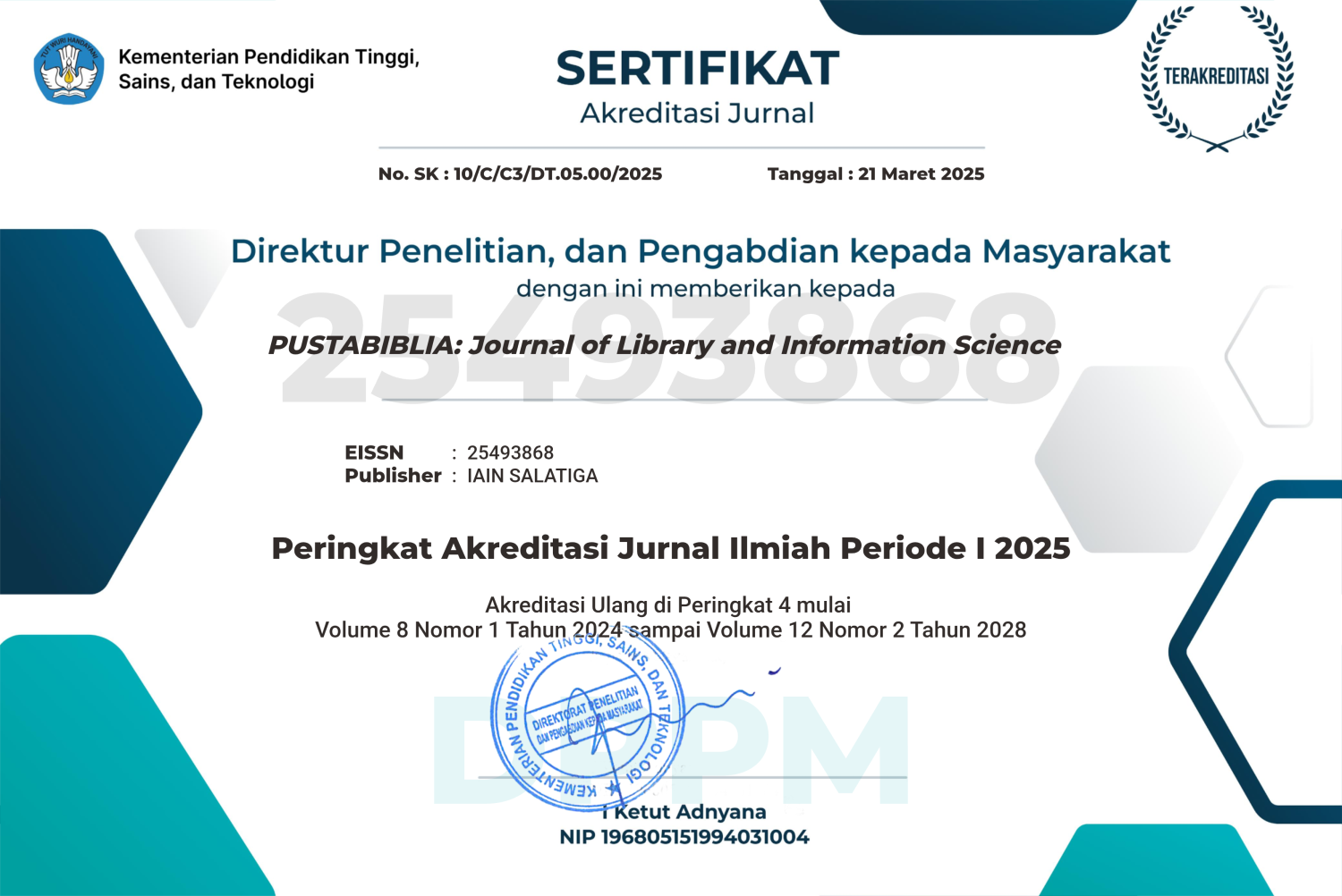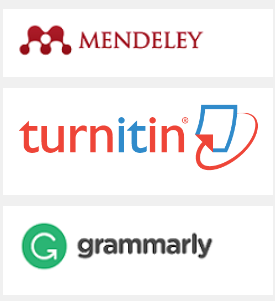Urgensitas kompetensi literasi digital pustakawan sebagai aktor komunikasi ilmiah dalam menunjang transformasi digital
DOI:
https://doi.org/10.18326/pustabiblia.v9i1.3826Keywords:
Digital transformation, digital literacy, scholarly communication, librarians, cultural heritageAbstract
Digital transformation in librarianship, particularly for librarians as actors in scholarly communication, marks a new era in the governance of digital knowledge products. This transformation presents opportunities for libraries to enhance their operational efficiency through technological integration. In this context, librarians’ digital literacy is a critical competency that supports the success of digital transformation in libraries. This competency extends beyond technological proficiency to include skills in managing and disseminating knowledge products, encompassing cultural heritage, local wisdom, and general knowledge. This study aims to explore the readiness of libraries in facing digital transformation, particularly in ensuring the sustainable accessibility of cultural heritage through digitization. The research employs a qualitative descriptive approach with an interpretative and constructivist perspective. Data collection is conducted through a literature review, while data analysis follows the Miles & Huberman model, comprising data reduction, data display, and verification. The findings indicate that the success of library digital transformation depends on three key aspects: operational agility, customer-centricity, and workforce competencies. Librarians’ digital literacy is a crucial factor in navigating these changes, encompassing technological capabilities, media interpretation, and skills in access, management, innovation, and collaboration. Furthermore, the digitization of cultural heritage has been identified as a priority to ensure broader access to information and the sustainable preservation of cultural assets in a modern format. Thus, librarians’ digital literacy is a determining factor in maintaining the relevance of libraries in the digital era and meeting the evolving information needs of society.
References
Abror, R. H., Mukhlis, M., Sofia, N., & Laugu, N. (2022). Social media and the collapse of literacy foundations among millennial Moslems. ICON-DEMOST. Semarang. doi:http://dx.doi.org/10.4108/eai.15-9-2021.2315581
Alghnimi, M., & Chaudhry, A. S. (2022). Status and practices of digitisation in Kuwaiti academic libraries. Malaysian Journal of Library & Information Science, 27(2), 115–129. doi:https://doi.org/10.22452/mjlis.vol27no2.7
American Library Association. (2003). How to Evaluate and Purchase an ILS. United State of America: American Library Association.
Anthonysamy, L., & Sivakumar, P. (2022). A new digital literacy framework to mitigate misinformation in social media infodemic. Global Knowledge, Memory and Communication, ahead-of-print(ahead-of-print). doi:https://doi.org/10.1108/GKMC-06-2022-0142
Bawden. (2008). Digital Literacy. Retrieved from http://www.scitopics.com/Digital Literacy.html
Bawden, D. (2001). Information and digital literacies: a review of concepts. Journal of Documentation, 57(2), 218-259. doi:https://doi.org/10.1108/EUM0000000007083
Bell, T. a. (2023, May 31). Digital Literacy, Definition and Resources What is Digital Literacy? . Retrieved from DIGITAL LITERACY & DIGITAL DIVIDE: http://cleach.wordpress.com/what-is-digital-li2015teracy/
Boise State University. (2018). Reproduction by Libraries and Archives. Retrieved from boisestate.edu: https://www.boisestate.edu/generalcounsel/copyright/copyrightbasics/section108/
Buchanan, P. R., & Sparagowski, C. (2022). The role of emerging technologies and social justice in emergency management practice: the good, the bad, and the future. Justice, Equity, and Emergency Management, 25, 175-199. doi:https://doi.org/10.1108/S2040-726220220000025008
Denzin, N. K., & Lincoln, Y. S. (1994). Handbook of Qualitative Research. London: Sage Publications.
Feerrar, J. (2019). Development of a framework for digital literacy. Reference Services Review, 47(2), 91-105. doi:https://doi.org/10.1108/RSR-01-2019-0002
Giri, R. (2012). NewGenLib 3: an integrated open source library management system that makes your library visible in web. Library Hi Tech News, 29(10), 4-12. doi:https://doi.org/10.1108/07419051211294464
Kari, H. K. (2020). Digital Transformation of Information and its Impact on Libraries. World Journal of Innovative Research, 9(1). Retrieved from https://www.wjir.org/download_data/WJIR0901033.pdf
Kozanoglu, D. C., & Abedin, B. (2021). Understanding the role of employees in digital transformation: conceptualization of digital literacy of employees as a multi-dimensional organizational affordance. Journal of Enterprise Information Management, 34(6), 1649-1672. doi:https://doi.org/10.1108/JEIM-01-2020-0010
Laugu, N. (2021). Power representation in the leadership of academic libraries in Indonesia. Berkala Ilmu Perpustakaan dan Informasi, 17(1), 85-97. doi:https://doi.org/10.22146/bip.v17i1.1043
Logan, R. K. (2010). Understanding New Media: Extending Marshall McLuhan. New York: Peter Lang.
Mackey, J. D., Ellen-III, B. P., Hochwarter, W. A., & Ferris, G. R. (2013). Subordinate social adaptability and the consequences of abusive supervision perceptions in two samples. The Leadership Quarterly, 24(5), 732-746. doi:https://doi.org/10.1016/j.leaqua.2013.07.003
MediaSmarts. (2022). Retrieved Jan 23, 2023, from Canada's Center for Digital and Media Literacy: https://mediasmarts.ca/
Meyers, E. M., Erickson, I., & Small, R. V. (2013). Digital literacy and informal learning environments: an introduction. Learning, Media and Technology, 38(4), 355–367. doi:https://doi.org/10.1080/17439884.2013.783597
Muronaga, K. a. (1999). The art of collaboration. Teacher-Librarian, 27(1), 9–14.
Natarajan, T. M. (2020). Digital Literacy Skills Among Library Professionals In Jimma University Libraries. Library Philosophy and Practice. Retrieved from https://digitalcommons.unl.edu/libphilprac/4629/
Nurdin, L., & Saufa, A. F. (2020). Home libraries and their roles in social changes among rural communities in Indonesia. DESIDOC Journal of Library & Information Technology, 40(06), 353-359. doi:https://doi.org/10.14429/djlit.40.06.15684
Oncul, G. (2021). Defining the need: digital literacy skills for first-year university students. Journal of Applied Research in Higher Education, 13(4), 925-943. doi:https://doi.org/10.1108/JARHE-06-2020-0179
Palfrey, J. (2015). BiblioTech: Why Libraries Matter More Than Ever in the Age of Google . New York: Basic Books.
Pangrazio, L., Godhe, A.-L., & Ledesma, A. G. (2020). What is digital literacy? A comparative review of publications across three language contexts. E-Learning and Digital Media, 1–18. doi:https://doi.org/10.1177/2042753020946291
Patra, N. K. (2017). Digital Disruption and Electronic Resources Management in Libraries. Cambridge: Chandos Publishing.
Pendit, P. L. (2008). Perpustakaan Digital dari A Sampai Z. Jakarta: Cita Karyakarsa Mandiri.
Pendit, P. L. (2019). Pustaka: Tradisi dan Kesinambungan. Jakarta: ISIPII.
Phippen, A., Bond, E., & Buck, E. (2021). Effective strategies for information 3 literacy education: Combatting ‘fake news’ and empowering critical thinking. Future Directions in Digital Information, 39-53. doi:https://doi.org/10.1016/B978-0-12-822144-0.00003-3
Rogers, E. M. (2003). Diffusion of Innovations. New York: Free Press.
Röglinger, H. G. (2015). Digital Transformation. Changes and chances - insights based on an empirical study. Sankt Augustin: Fraunhofer-Institut für Angewandte Informationstechnik FIT .
Rubin, R. E. (2004). Foundations of Library and Information Science. New York: Neal-Schuman Publisher.
Schamber, L. (1990). Automation for the school library media center: An ERIC Digest. United State of America: Office of Educational Research and Improvement, U.S. Department of Education. Retrieved from http://librarytechnology.org/repository/item.pl?id=8697
Shahrokh Nikou, M. D. (2022). Workplace literacy skills—how information and digital literacy affect adoption of digital technology. Journal of Documentation, 78(7), 371-391. doi:https://doi.org/10.1108/JD-12-2021-0241
Singh, B. (2018). Digital Transformation of library services in the Mobile World: The future trends. Publishing Technology and Future of Academia, 338. Retrieved from https://www.researchgate.net/publication/329609554_Digital_Transformation_of_library_services_in_the_Mobile_World_The_future_trends
Stolterman, E. a. (2004). Information Technology and the Good Life Information Systems Research: Relevant Theory and Informed Practice. London: Kluwer Academic Publishers.
Sugiyono. (2013). Metode penelitian kombinasi (mixed method). Bandung: Alfabeta.
Tinmaz, H., Fanea-Ivanovici, M., & Baber, H. (2021). A snapshot of digital literacy. LIBRARY HI TECH NEWS, 1-4. doi:https://doi.org/10.1108/LHTN-12-2021-0095
Transformation, T. I. (2021, May Monday). Impact of Digital Transformation on the Future of Library. Retrieved from https://www.institutefordigitaltransformation.org/impact-of-digital-transformation-on-the-future-of-library-work/
United States Constitution. (2022). Copyright Law of the United States and Related Laws Contained in Tıtle 17 of the United States Code. United States of America: United States Copyright Office.
Verma, N. K., Deori, M., & Verma, M. K. (2022). Library services during COVID 19: a usability analysis of websites of the central university libraries in India. DESIDOC Journal of Library & Information Technology, 42(6), 341-353. doi:https://doi.org/10.14429/djlit.42.6.18130
Vogels, E. A. (2019). Millennials stand out for their technology use, but older generations also embrace digital life. Retrieved Jan 24, 2023, from Pew Research Center: https://www.pewresearch.org/fact-tank/2019/09/09/us-generations-technology-use/
Downloads
Published
Issue
Section
License
Copyright (c) 2025 Mukhlis

This work is licensed under a Creative Commons Attribution-ShareAlike 4.0 International License.
Copyright
Authors retain copyright and grant the journal right of first publication with the work simultaneously licensed under a Creative Commons Attribution-ShareAlike 4.0 International License. In line with the license, authors are allowed to share and adapt the material. In addition, the material must be given appropriate credit, provided with a link to the license, and indicated if changes were made. If authors remix, transform or build upon the material, authors must distribute their contributions under the same license as the original.
Licensing

This work is licensed under a Creative Commons Attribution-ShareAlike 4.0 International License.







